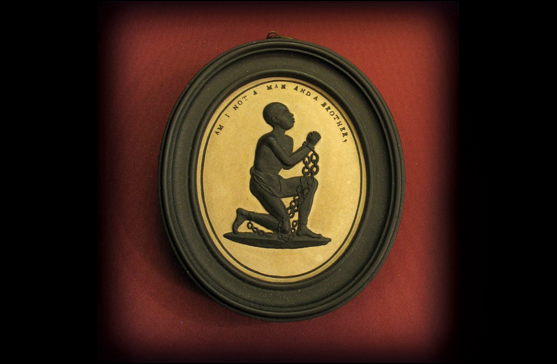
Wedgwood: Beyond the table
The 'father of English potters' was also a Unitarian and an anti-slavery advocate.
Wedgwood was born in Burslem, Staffordshire, England, in 1730, the youngest of twelve children. His mother, Mary, was the daughter of a Unitarian minister. His father, Thomas, came from a long line of potters. Following Thomas’s death, the nine-year-old Wedgwood left school and was apprenticed to his brother. He contracted smallpox when he was eleven, which left him with a knee infection that made working a potter’s kick wheel difficult, so he turned his professional focus toward development and marketing. His knee would continue to trouble him until he had the leg amputated in 1768.
Wedgwood was an active Unitarian and interested in science and political and social reform. He was close friends with scientist and Unitarian minister Joseph Priestley, social reformer Thomas Day, inventor Erasmus Darwin, and prominent abolitionist Thomas Clarkson. His factory was progressive for its time, offering decent working conditions and an early form of sick-benefit plan. He supported American independence, the French Revolution, and the abolition of slavery.
In 1787, Wedgwood became an influential member of the newly formed Society for the Abolition of the Slave Trade. He designed, produced, and distributed at his own expense a cameo based on the Society’s seal, featuring a kneeling black man in chains and the motto “Am I not a man and a brother?” A precursor to the modern campaign button, these medallions were among the first fashion accessories to show the wearer’s support for a political cause and were worn as jewelry, cufflinks, and hatpins. The design was also printed on dishes and tea caddies. “At length the taste for wearing them became general,” Clarkson wrote, “and thus fashion, which usually confines itself to worthless things, was seen for once in the honorable office of promoting the cause of justice, humanity and freedom.”
In 1788 Wedgwood sent a batch of the medallions to Benjamin Franklin, who wrote that he believed they “may have an effect equal to that of the best written pamphlet.”
Wedgwood was also an inventor. In 1759, he was working as an independent potter and had begun experimenting with clays, glazes, colors, and forms. Between 1762 and 1774 he invented and produced three of the Wedgwood company’s most celebrated and enduring ceramic bodies—Queen’s Ware, Black Basalt, and Jasperware. The distinctive light blue shade of some of his pottery has come to be known as Wedgwood Blue.
Wedgwood also invented the pyrometer, which measures the super-high kiln temperatures reached during pottery firing. For this innovation, he was elected a member of the Royal Society in 1783.
He married his third cousin, Sarah Wedgwood, in 1764, and often sought her opinion on new pottery designs. The couple had eight children; the eldest, Susannah, was Charles Darwin’s mother.
By 1794, Wedgwood’s health was in decline and he died in January 1795, likely from cancer of the jaw. However, his influence has lived on in the success of many of his social causes, the endurance of his inventions, and the continued popularity of his innovations in earthenware.
This article appeared in the Fall 2014 issue of UU World (pages 53–54). Photograph (above): An anti-slavery medallion designed by Josiah Wedgwood (cc seriykotik1970). See sidebar for links to related resources.
Comments powered by Disqus






